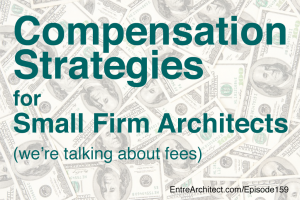Compensation Strategies for Architects
How do you get paid? How to you structure your fees as an architect? Architects love to talk about this topic!
This week at EntreArchitect Podcast, Mark R. LePage shares his Compensation Strategies for Architects.
Note: This episode is about how Mark structure’s the compensation strategies for his own firm. These strategies work for him. You should structure your fees in ways that work best for you and your firms. Entrearchitect.com has lots of information on understanding fees, how to be profitable, and how to figure out what your fee should be.
Inspired by the EntreArchitect Facebook Group
Our Facebook group is active with architects throughout the world. Everyone can share successes and failures in an open, transparent forum that’s private for only those who are in the group. It’s free to join, but you must be an architecture student or architect of any type and any size firm.
Every week, Mark and other EntreArchitect Facebook group members post several thoughtful questions and all members of the group are able to collaborate on varying topics such as the following:
- How do you remain confident in a room full of folks with many years of knowledge and experience ahead of you?
- What does everyone do for secondary/passive income?
- I’m running out of cash and I don’t have a single client or project to work on. I just started, but it’s really stressful knowing that the source of cash is diminishing and soon I won’t be able to attend to my family’s needs. Any thoughts?
- I’m currently working with the most dysfunctional husband and wife client of my career. They can’t make or keep decisions and they incessantly argue about the smallest things using the most brutal terms right in front of me. I always thought that a good residential architect should also be a good marriage counselor, and I’ve prided myself on those skills, but I have met my match. Any suggestions, comments or similar stories?
- Are you struggling with the transition from CAD to BIM?
- What’s a good construction detailing book?
- What kind of car do you drive and what does that say about you as an architect?
Background
Mark has a small architecture firm, Fivecat Studio Architecture, made up of himself and his wife, Annmarie. They’re based about 40 minutes north of New York City, and they focus on high-end additions and alterations.
Fee Structures for Fivecat Studio
Fivecat Studio’s basic compensation is 12% of the cost of construction. Depending on the client or the project, they may use different types of fees.
A hybrid fee starts with an initial payment of about 10% of the project prior to the schematic design phase. At the end of schematic design and having a full understanding of the project, they get a construction cost estimate. If the client wants to move forward, they put together a scope of work and base their fees on a schedule broken into $25K increments of construction costs.
Mark’s preference, the percentage of construction fee is based on the client’s budget. Once they know what the client wants to spend, they can put together a proposal. After a schematic design is complete and approved, the project goes through to bid and the fee adjusts to the final cost of construction.
Hourly works for a lot of other architects, but for Mark, hourly has always felt like a monthly negotiation. Flat fees are too hard to predict with different clients, project, expected quality levels, contractors, and more.
Mark has learned over the years that it’s easier to develop systems around the beliefs and expectations of the clients rather than to try and convince them that he’s correct as the architect. Instead of trying to justify everything, Mark developed the hybrid fee based on the client’s existing expectations.
Compensation
For Mark’s firm, compensation is divided into 5 phases:
- Schematic design – 25% of total fee
- Design development – 25% of total fee
- Construction documents – 25% of total fee
- Bidding and selection of a general contractor – 5% of total fee
- Construction administration – 20% of total fee
Construction Administration is part of the base fee for architectural services. Every architect should provide construction administration as a mandatory service for every client.
Architects perform much more work on projects that’s not in the basic scope of services. If it’s not included in your basic services, you should be paid for any additional work you do. Many architects are performing additional services that they aren’t getting paid for and leaving significant amounts of money on the table.
One way to keep up with this is to manage your clients’ expectations. If you’re clear about what a project will take and what each piece will cost, your client will be prepared to pay for it.
Some additional services provided include master planning, construction management, and more.
Coordination of Consulting
Have you been on a project when a client says they’re going to take care of some part of the project? Often, you end up consulting or coordinating on their work. If so, you should be paid for those services.
Initial Payment Retainer
Typically our initial payment is based on 10% of the total fee based on expected construction costs. Upon signing the contract, the client pays that initial 10% and it’s held until the final invoice where it’s 100% refunded as a credit to the invoice.
However, Mark is considering making a change because of a post in the EntreArchitect Facebook Group. The point of the initial payment is protection and if a project is cancelled, it’s currently refunded 100%. Recently, Mark had a project that’s dragged on for several years. The firm has been compensated for all the work that’s been done, but, after some time, the project was cancelled. Now, they have to refund the full initial 10% payment?
Moving forward, Mark plans to credit a percentage of the initial payment at the end of each phase, instead of the very end. With this model, the balance of the initial payment is non-refundable and transferred to the architect upon termination for costs related to project close out.
Strategies for Getting Paid Faster
- Be consistent by billing on the same day of the month
- Follow up on your invoices
- Accept credit cards and electronic payments
- Always send reimbursement invoices separately from fee invoices
Question: Describe your fee structure. What works and what needs improvement?
Head over to the EntreArchitect Facebook Group and share your thoughts.
Visit our Platform Sponsors
NCARB is helping architects reach their goals! Get back on track with the new AXP (Architectural Experience Program) Portfolio by submitting an online portfolio and meeting your state’s requirements to get one step closer to becoming an architect! Visit NCARB.org to learn more today.
TruStile is a leader in high end, architectural interior doors that never fail to perform. They’re passionate about providing inspiration and tools to transform your designs with the most authentic and distinctive doors available. Visit them at EntreArchitect.com/Trustile to download the New American Home case study, watch the video and learn more!
Freshbooks is the easy way to send invoices, manage expenses, and track your time. Learn more at FreshBooks.com.
Access Your 30-Day Free Trial at FreshBooks.com/architect (Enter EntreArchitect)
Referenced in this Episode
EntreArchitect Profit for Small Firm Architects course (free)
EntreArchitect Hybrid Proposal for Architectural Services
The post EA159: Compensation Strategies for Small Firm Architects [Podcast] appeared first on EntreArchitect // Small Firm Entrepreneur Architects.

